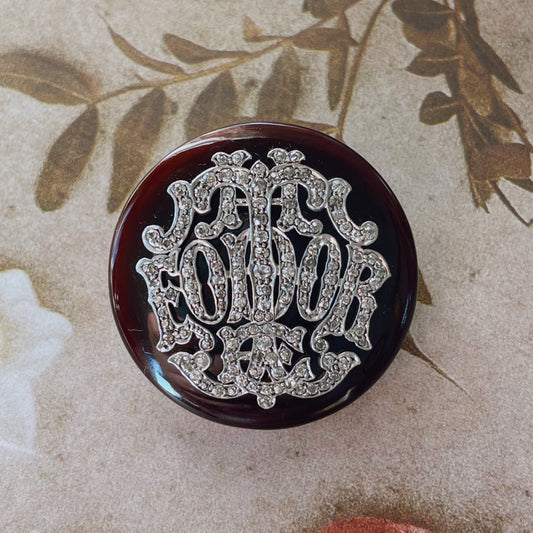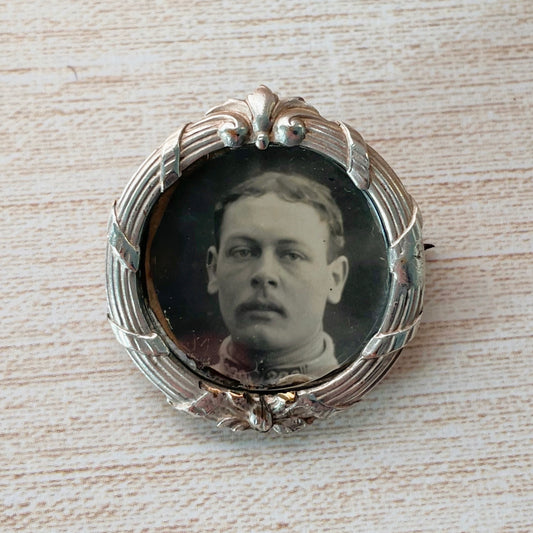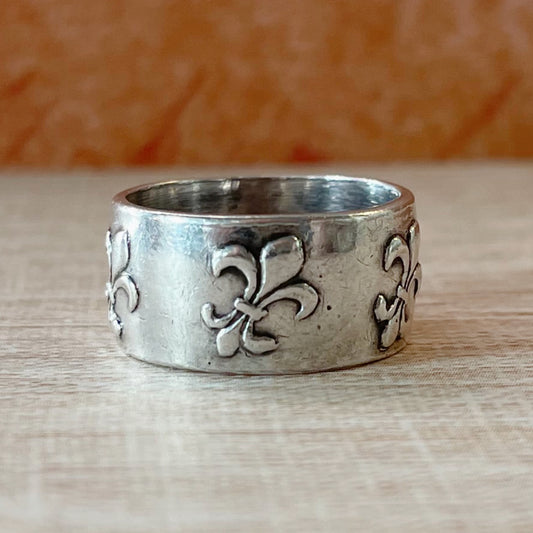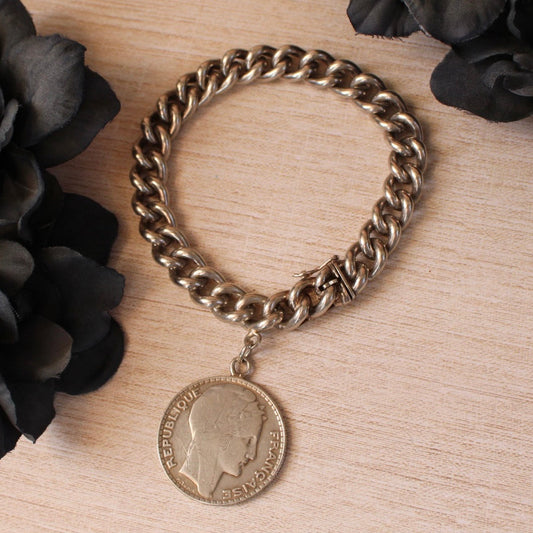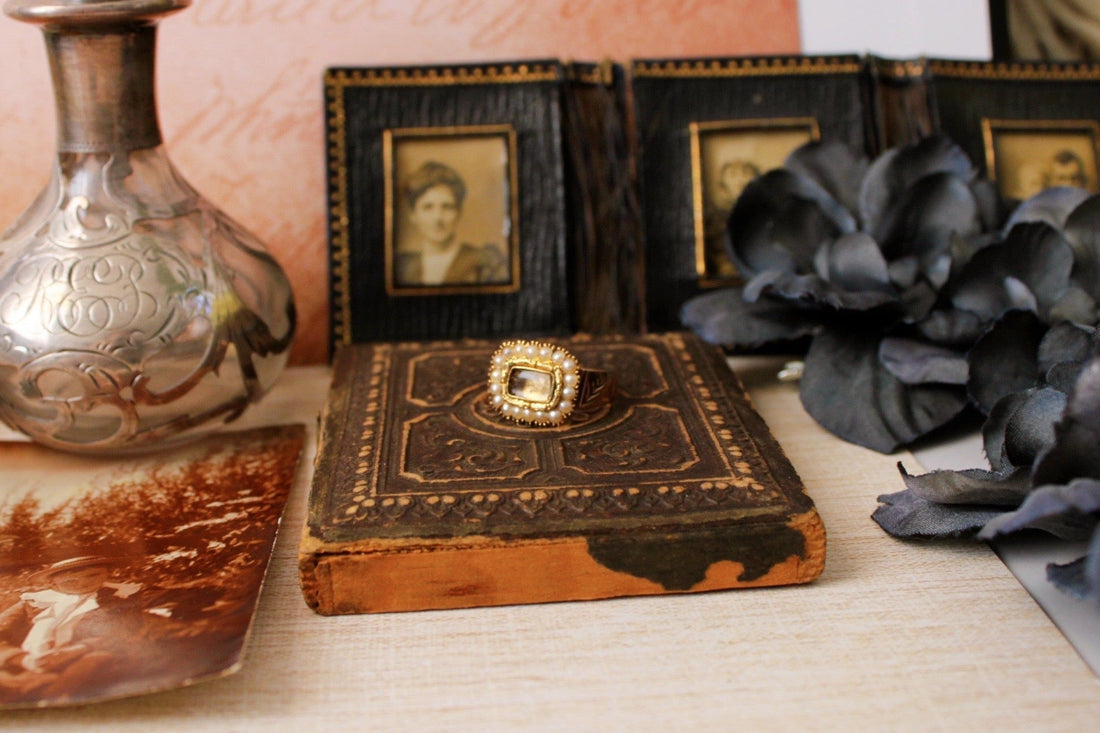
Antique Mourning Jewelry: Sentiment and Symbolism
Share
Before we had devices capable of connections in our pockets and endless digital memories, people turned to tangible, beautiful objects to honor those they had lost or who they would never again see in their lifetime. Among the most intimate and enduring of these keepsakes is mourning jewelry, a tradition that combines artistry, symbolism, and deep emotional resonance.
What Is Mourning Jewelry?
Mourning jewelry refers to pieces created to commemorate a loved one who has passed. Although forms of memorial adornment date back centuries, the tradition especially flourished during the 18th and 19th centuries, reaching its peak during Queen Victoria’s long mourning period after the death of Prince Albert. The last examples we see of mourning are around the 1920s.
These loved pieces weren’t merely just accessories; they were personal, often custom-made tributes to those no longer present, worn as a form of remembrance, respect, and love.
Materials with Meaning
Every element of mourning jewelry was carefully chosen for its symbolism:
Jet: This velvety-black fossilized wood was highly prized in Victorian mourning fashion. Mined mainly in Whitby, England, its black color was symbolic of death and grief. Its lightweight and smooth texture made it ideal for intricate, comfortable jewelry.
Human Hair: Often intricately braided, curled, or woven into floral motifs and patterns, hair from the deceased added an intimate, physical connection to the wearer. Human hair was used in mourning because it was a lasting and tangible memento of the deceased that did not decay. (Hence why we still have examples today!) This practice, known as hairwork, was prominent in the Victorian era and was used to create jewelry and art to memorialize loved ones, embodying sentiments of love, friendship, and remembrance in a physical form.
Enamel: Black enamel signified mourning, while white sometimes appeared in pieces made for children or young, unmarried individuals.
Gold, Pearls & Garnets: Gold offered a soft contrast to darker materials. Seed pearls represented tears, and garnets were sometimes used for their rich, blood-red symbolism.
Miniatures & Photographs: Portraits—hand-painted or photographic—were often enclosed in lockets or rings, offering a literal face to memory.
Symbolism in Design
Mourning jewelry is full of symbolism, much of it deeply poetic:
Urns & Weeping Willows: Representing sorrow and remembrance.Skulls & Crossbones: Reminders of mortality (memento mori) and the fragility of life.
Angels & Crosses: Spiritual imagery reflecting faith in the afterlife.
Eyes: “Lover’s eye” jewelry—a painted eye of a loved one—was both personal and mysterious.
Floral Motifs: Forget-me-nots, lilies, and roses often signified memory, purity, and eternal love.
Oak trees: Used in Victorian mourning because their symbolism—representing strength, endurance, and longevity—comforted the bereaved during a time of loss. This symbolism was expressed through motifs in jewelry like the use of bog oak, and in funeral art and cemeteries, where oak leaves and acorns could signify courage, power, and eternal life.
A Glimpse into Mourning Customs
Mourning wasn’t just personal; it was a public expression. Victorian etiquette dictated how long someone should mourn (especially women), what colors they could wear, and what kind of jewelry was appropriate. Not following the rules could suggest a lack of love or respect for the deceased.
The Victorian double standard for mourning stemmed from the strict separation of public and private life, as well as the different duties of men and women. Strict mourning attire was primarily for women because it served as a public representation of the family's grief, wealth, and social status. This stark difference in expectations was reinforced by the era's rigid gender roles, which assigned men and women to separate social spheres.
Men typically wore black coats, or a black crepe armband or band around their tophat.
Queen Victoria's long, public mourning for her husband, Prince Albert, reinforced and cemented these societal expectations across all classes. After he died in 1861, she wore black for the remaining 40 years of her life, making intense and prolonged grief highly fashionable and influential. This royal example encouraged even stricter adherence to mourning protocols among the public, placing a heavy burden of performing grief on women.
Because of this, jewelry became a wearable part of grief, signaling to others the depth of your loss, but also celebrating the life and connection you still carried with you.

Mourning Dress, American ca. 1848. (n.d.). The Met. https://www.metmuseum.org/art/collection/search/80526

Major General William Tecumseh Sherman wearing mourning armband. (1865). The Met. https://www.metmuseum.org/art/collection/search/301993
Why We’re Still Drawn to It
Today, mourning jewelry offers something rare that no other jewelry can match: a glimpse into another time’s intimate emotional world. For collectors, artists, and romantics at heart, these pieces are:
Historically rich: Each piece tells a story long gone with time, sometimes even inscribed in its metal or woven into its design.
Beautifully handcrafted: From delicate hairwork to masterful miniature painting, the craftsmanship is breathtaking. Most of these techniques are unfortunately lost with time and are practically impossible to recreate.
Emotionally resonant: These weren’t mass-produced jewelry like we see today. They were tokens of love, made to be worn close to the heart and extremely customized and personal.
Whether you wear it or display it, mourning jewelry invites reflection, reverence, and a bit of wonder.
Caring for Mourning Jewelry
If you're lucky enough to own or collect antique mourning jewelry, it’s important to care for it properly to preserve both its beauty and history.
Here are some gentle tips:
🖤 Avoid Harsh Chemicals
Many pieces contain delicate materials—like enamel, jet, or hairwork—that can be damaged by cleaning products or even water. Stick to a dry, soft cloth for most cleaning.
🖤 Store with Care
Keep your jewelry in a padded box or wrapped in acid-free tissue paper. Moisture and sunlight can damage organic materials, especially hair and jet.
🖤 Limit Wear
While it’s tempting to wear these beautiful pieces often, they’re fragile. If you wear mourning jewelry, avoid exposure to water, perfume, and excessive handling.
🖤 Know When to Ask a Pro
For cleaning or repairs, seek out a jeweler who specializes in antique or sentimental jewelry. Some of these items are over 150 years old and require a delicate touch.
With the right care, mourning jewelry can be passed down through even more generations, still telling its story, still offering a moment of connection to the past.
Final Thoughts...
Antique mourning jewelry isn’t just about death. It’s about love, memory, and resilience. These pieces remind us that even in loss, humans found ways to create something meaningful and lasting. We can create something beautiful from sorrow.
Whether you’re a collector, a history lover, or simply intrigued by the romance of the past, mourning jewelry is a powerful reminder: grief and beauty have always gone hand in hand.
Locket made in Boston, Massachusetts, United States 1706. (n.d.). The Met. https://www.metmuseum.org/art/collection/search/16782






